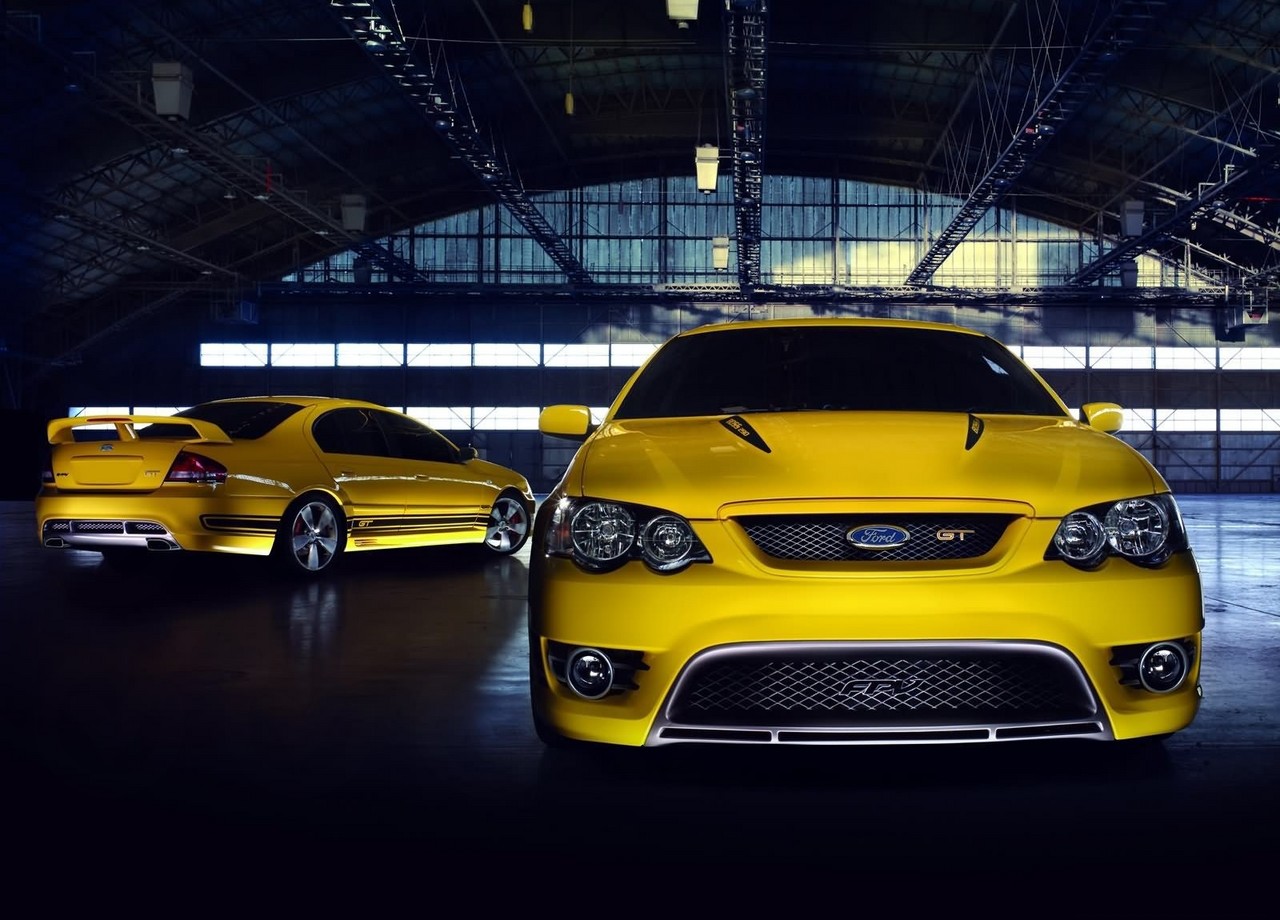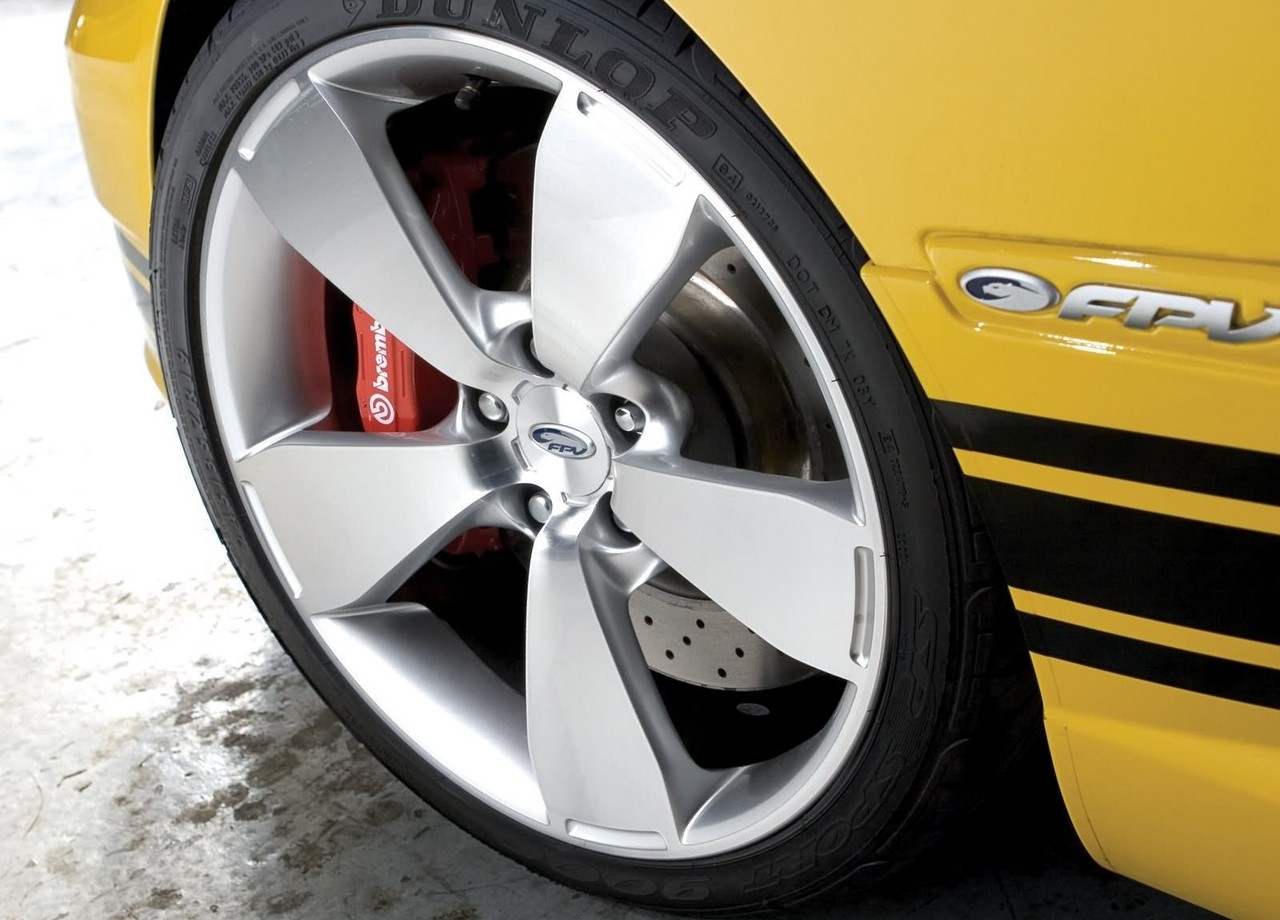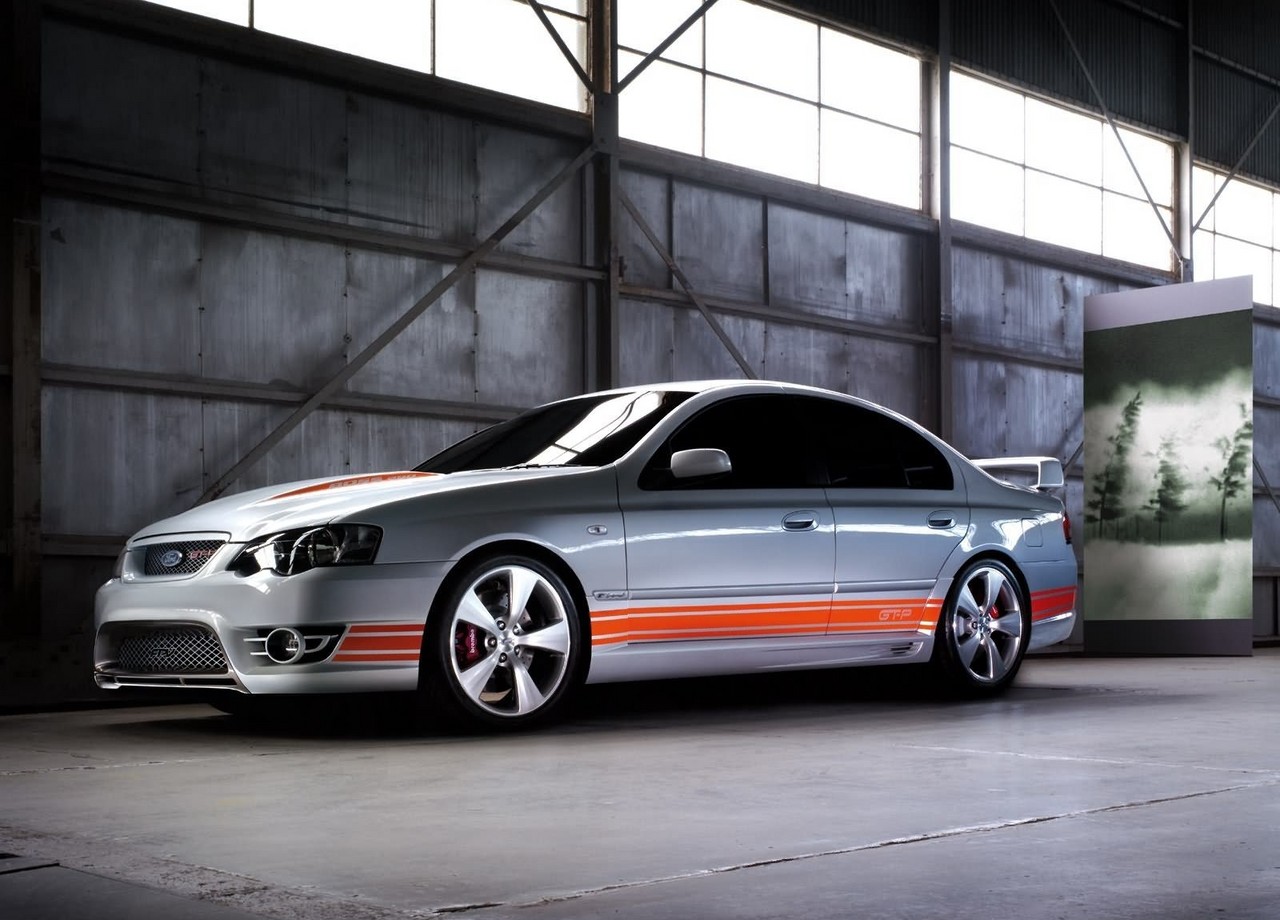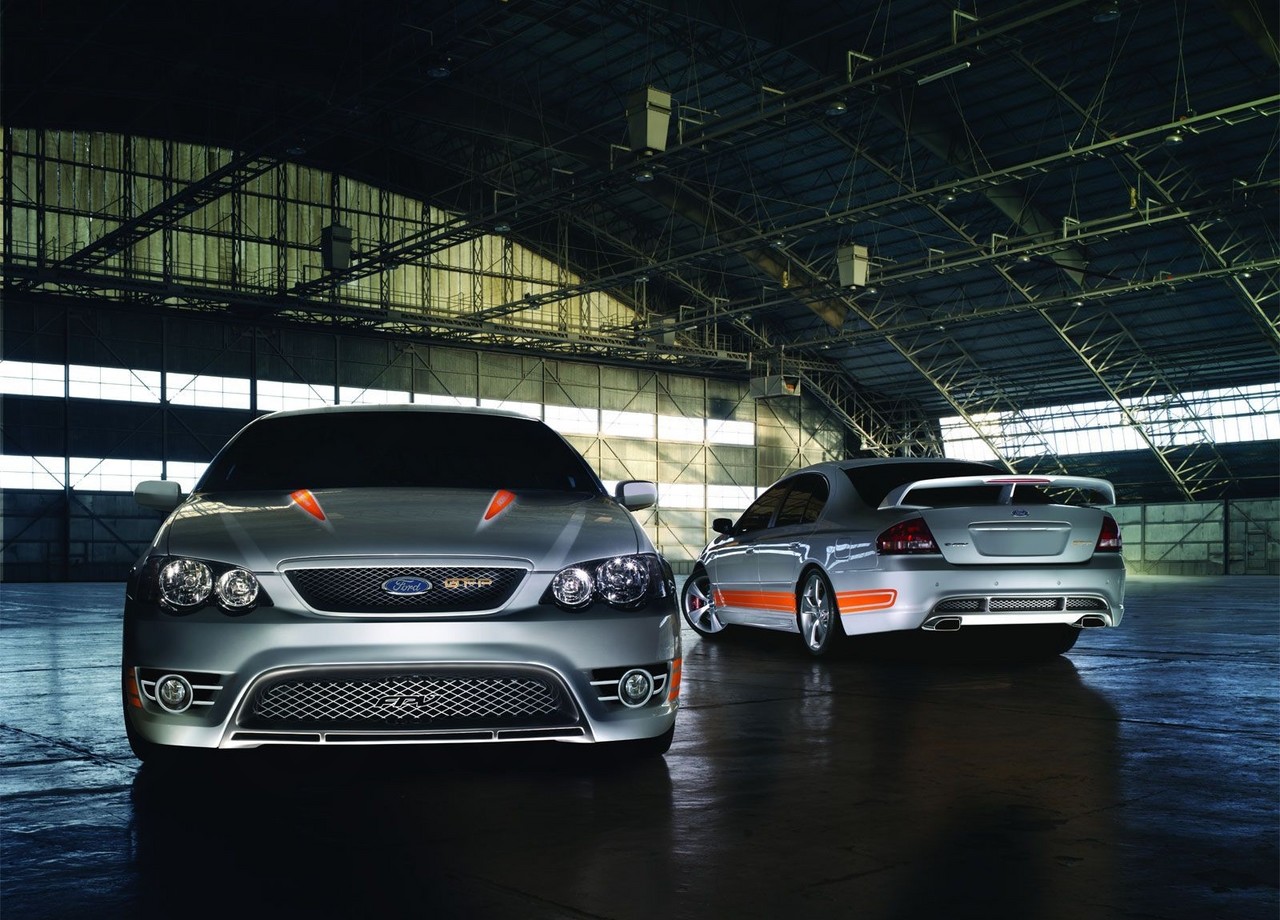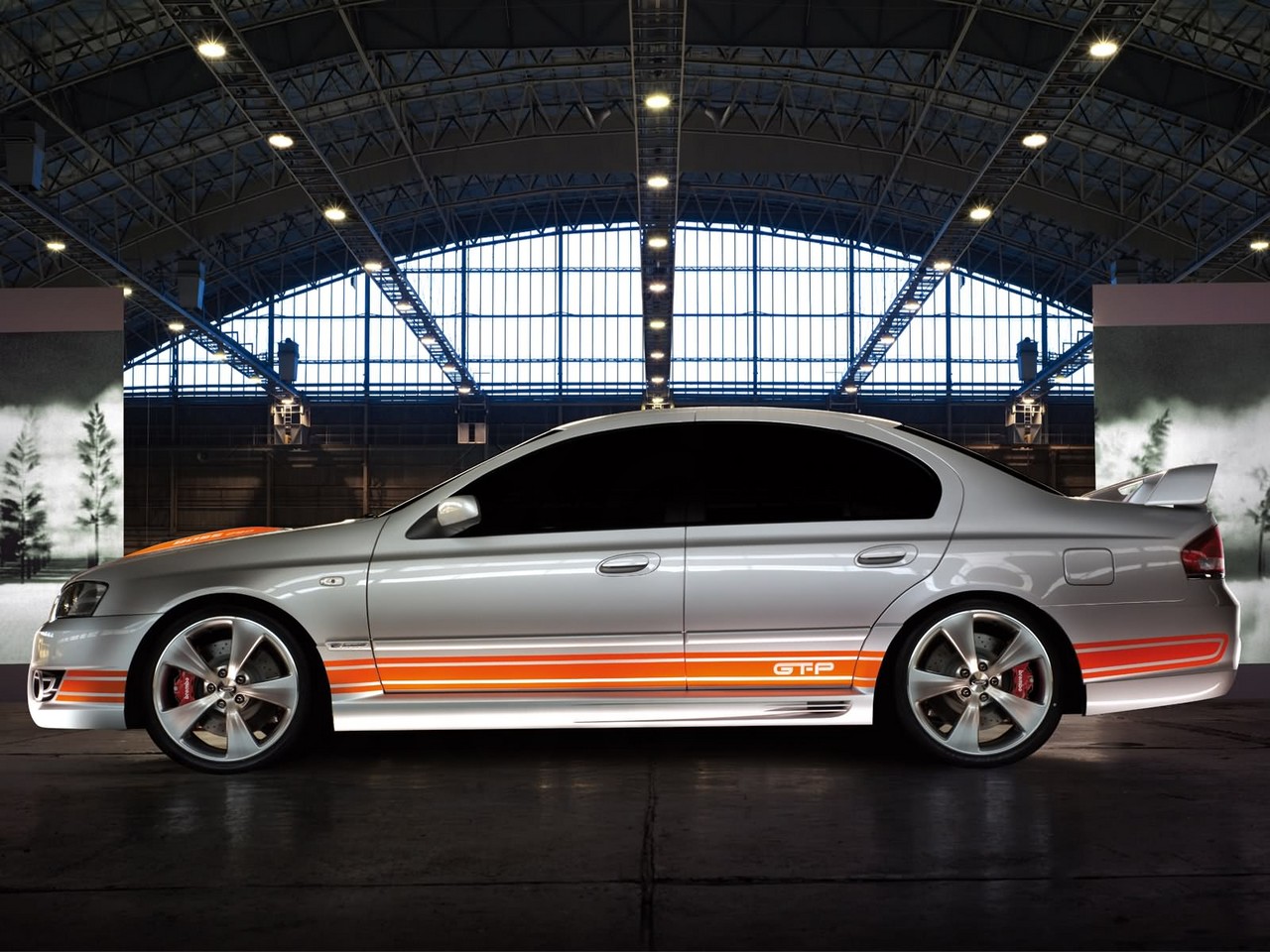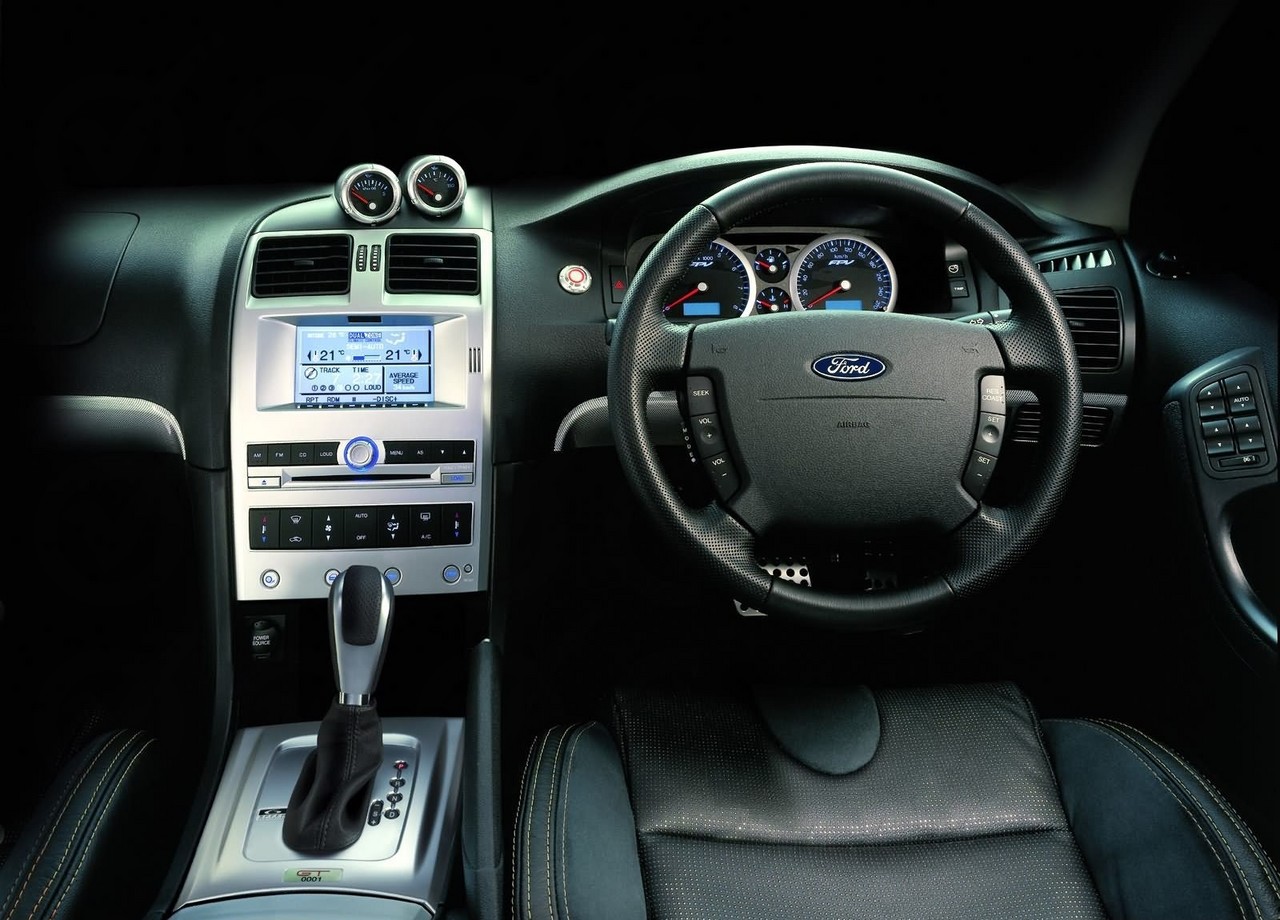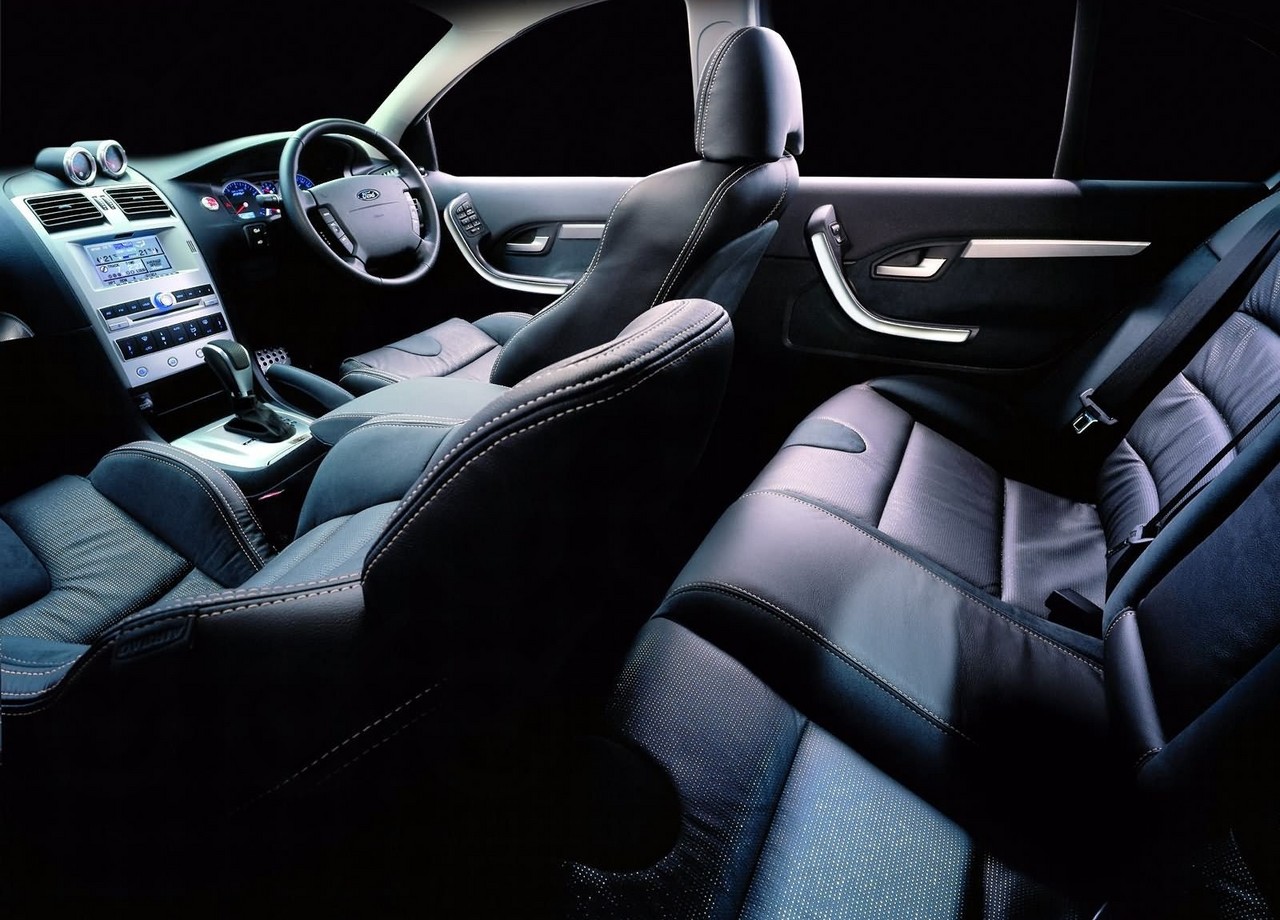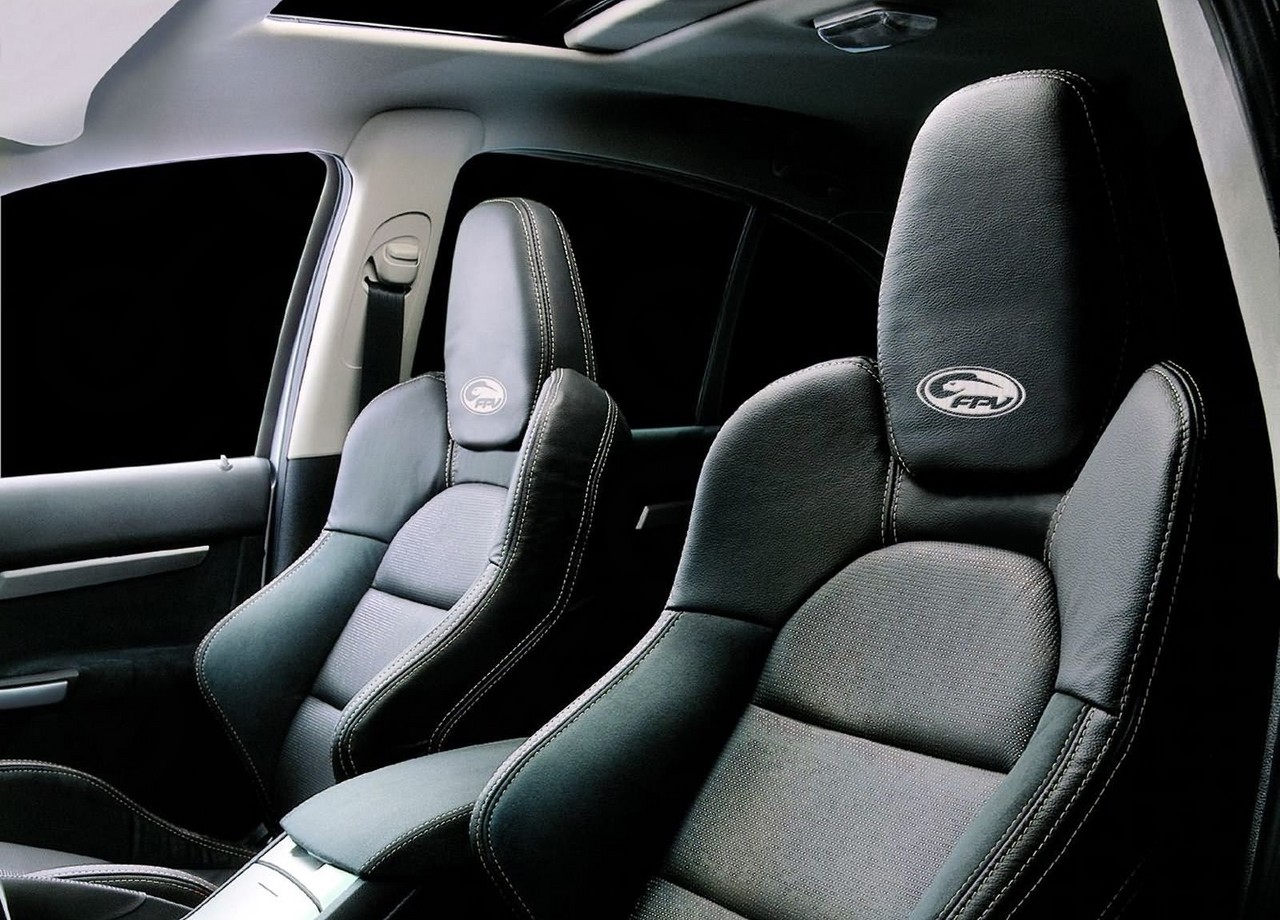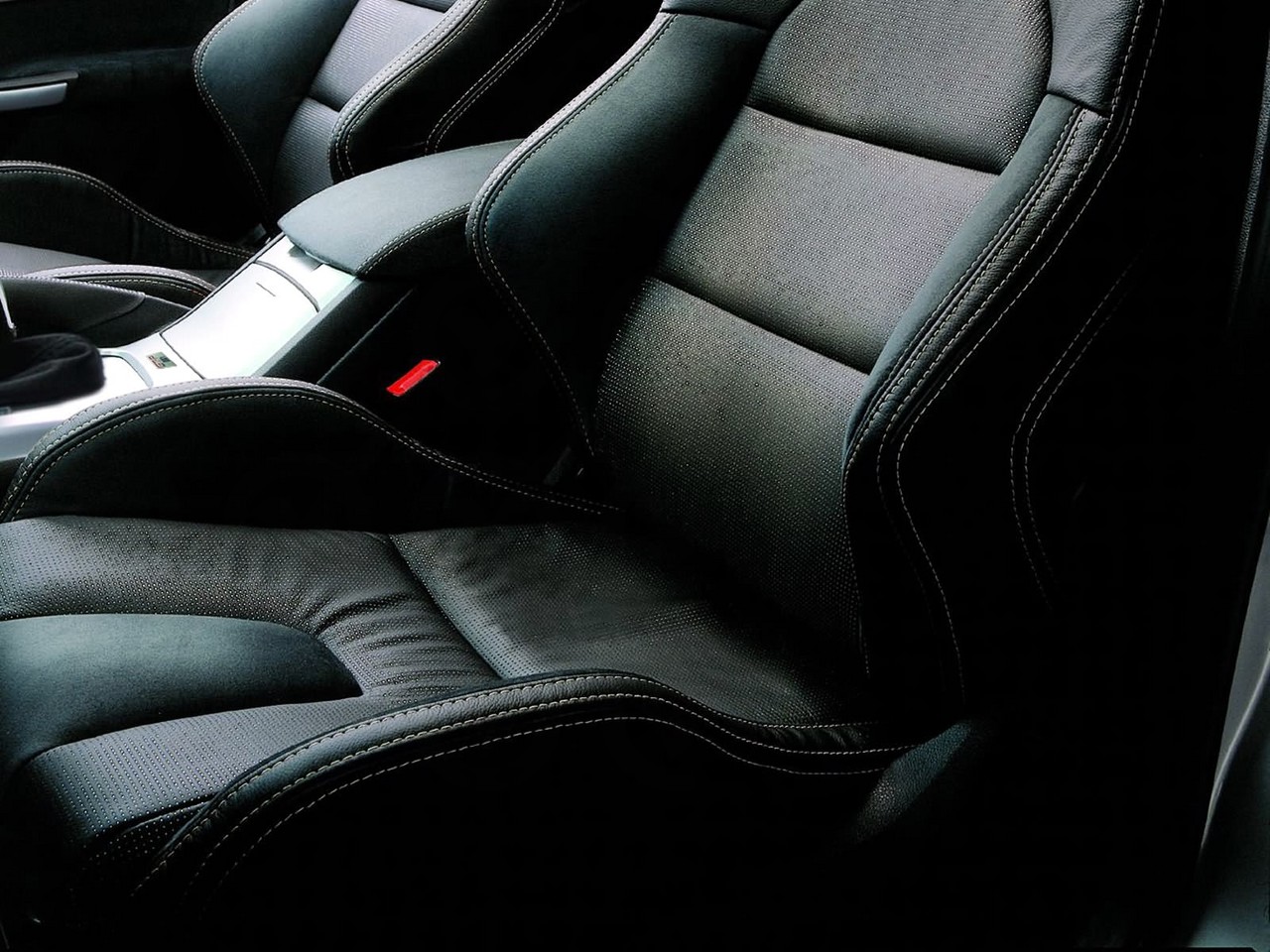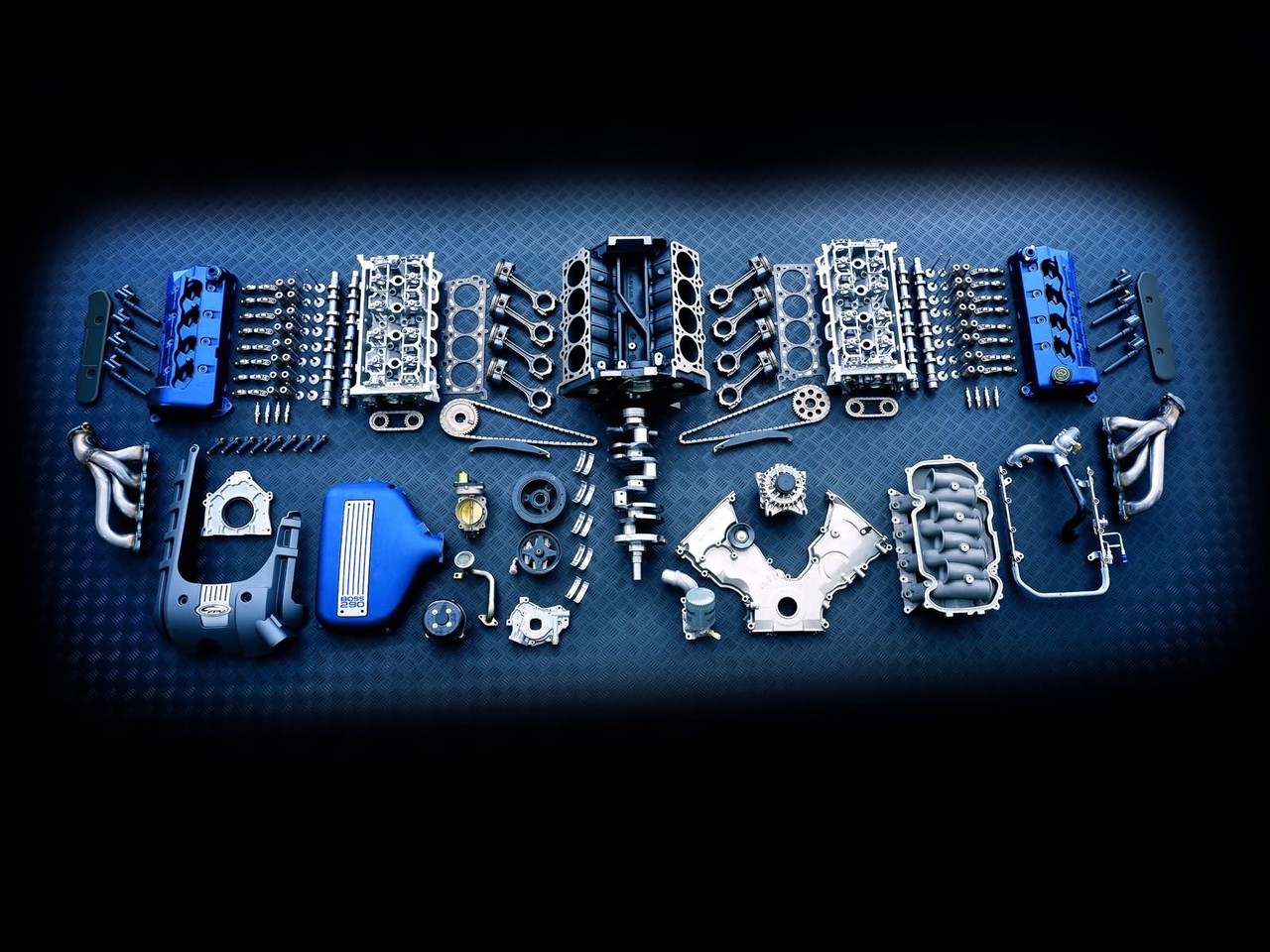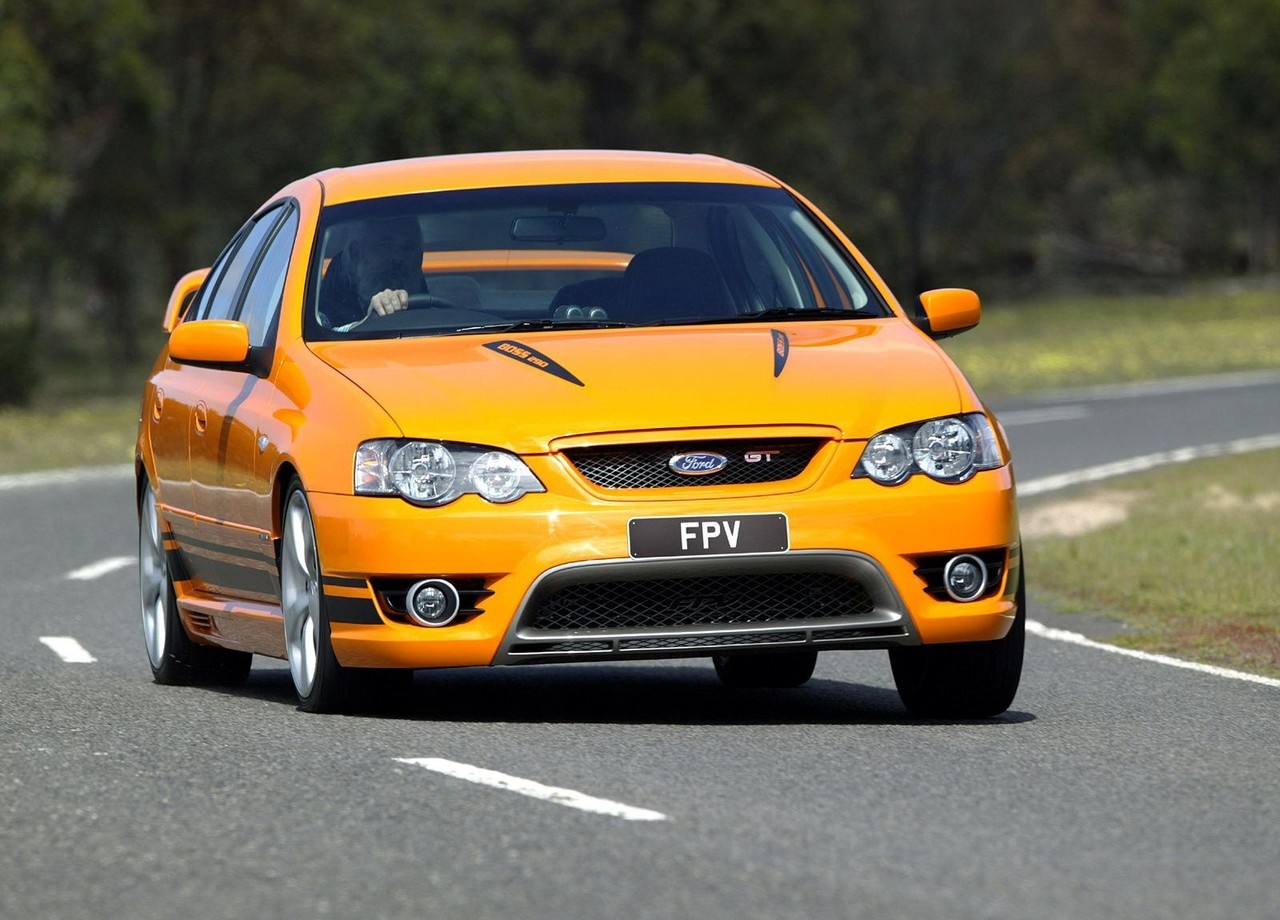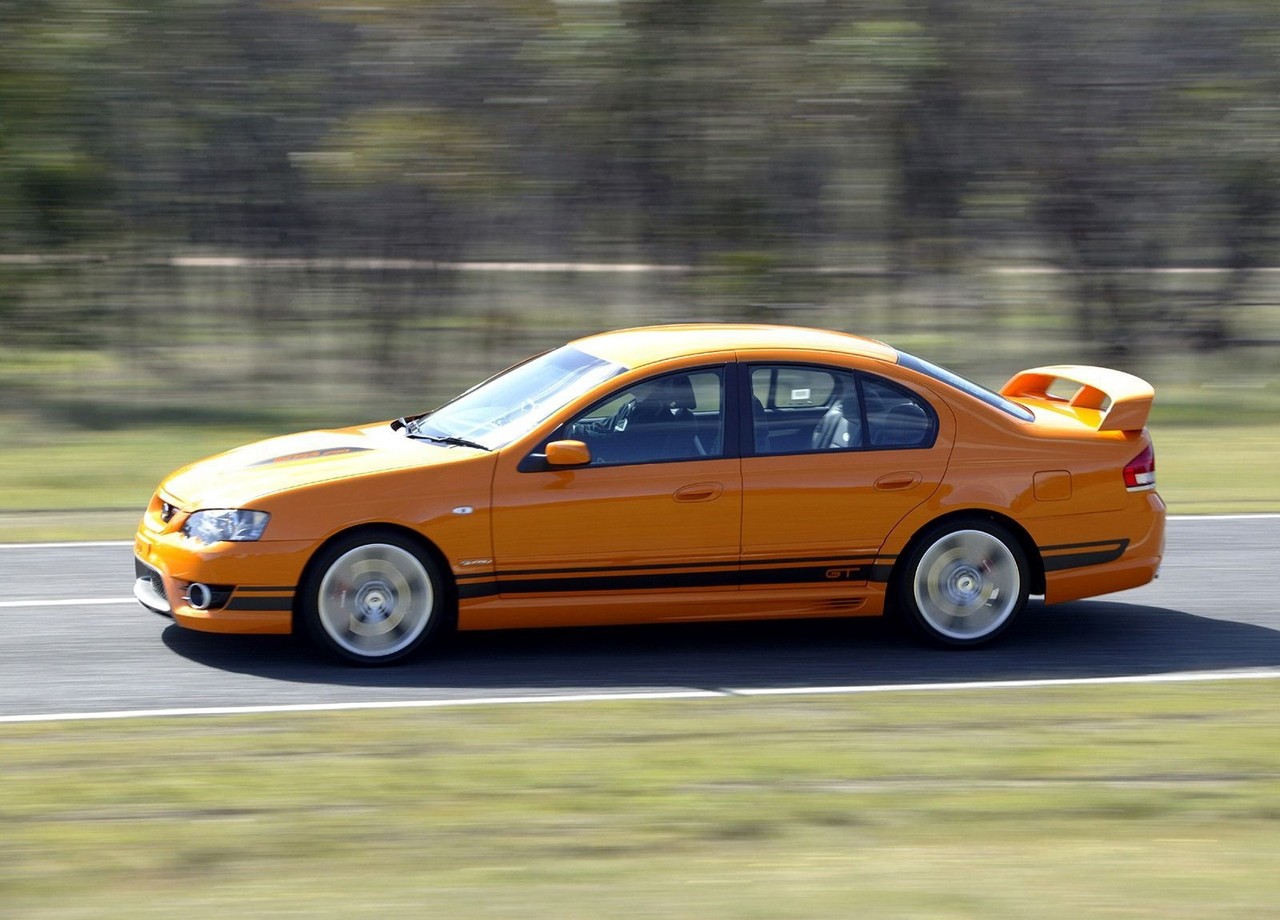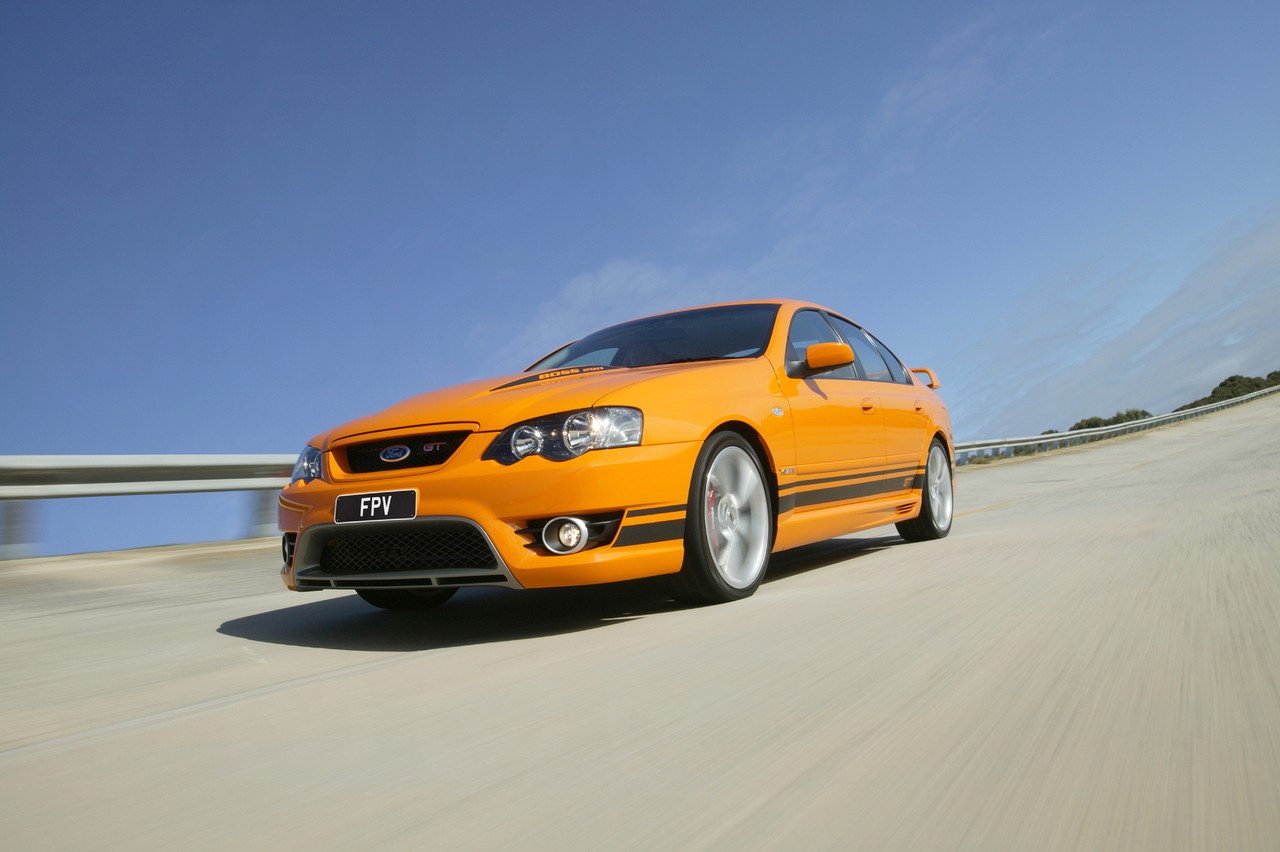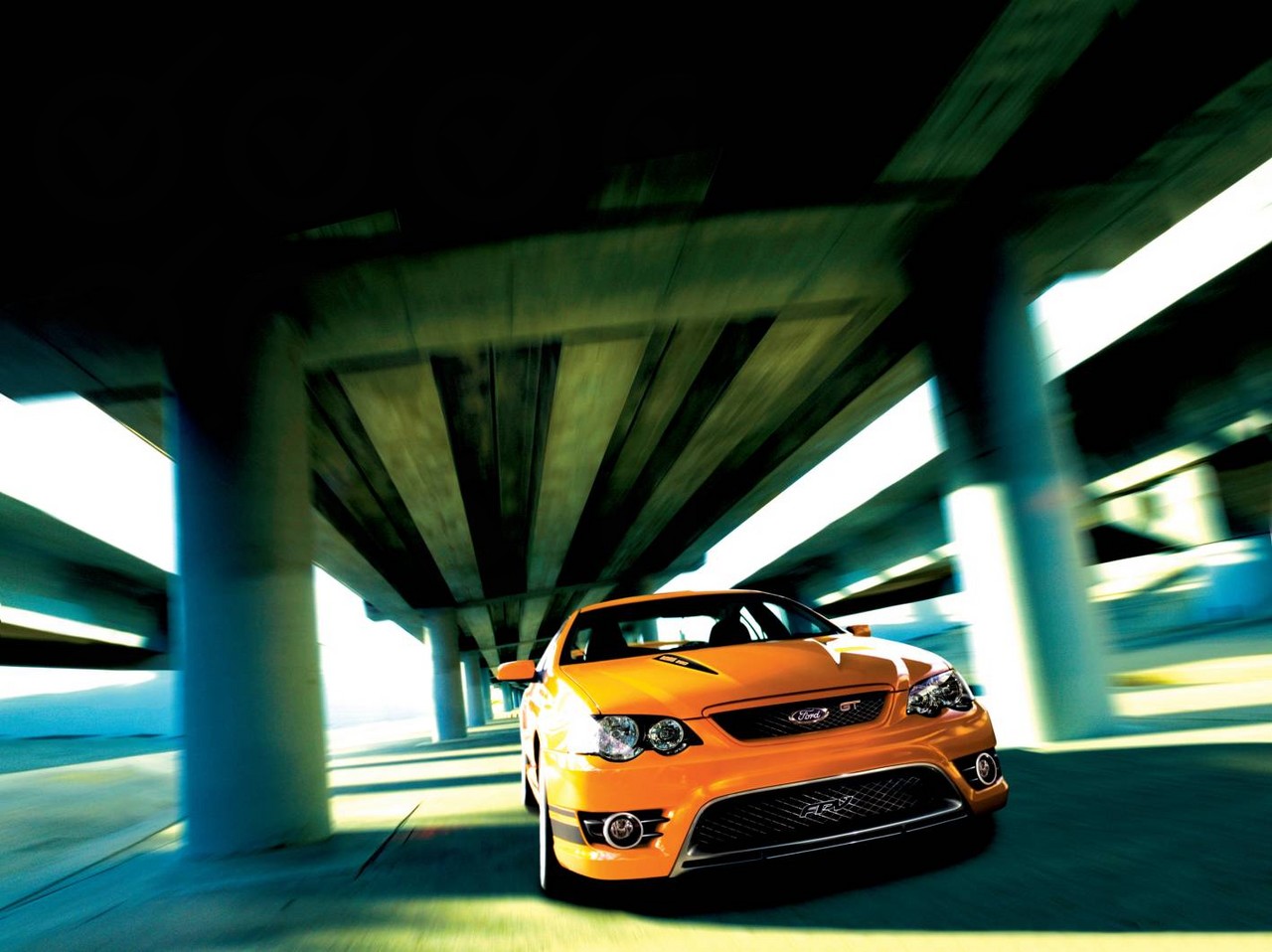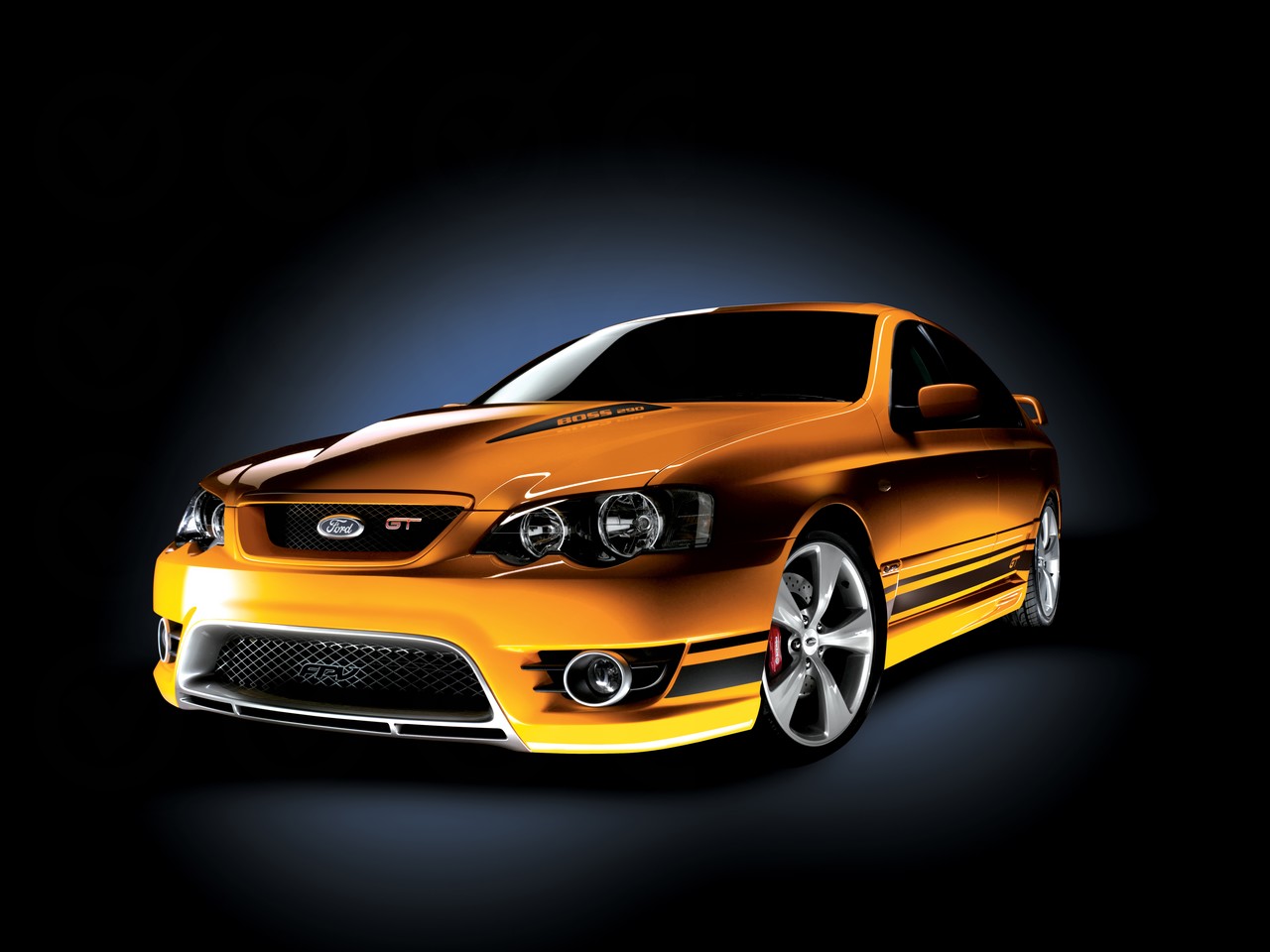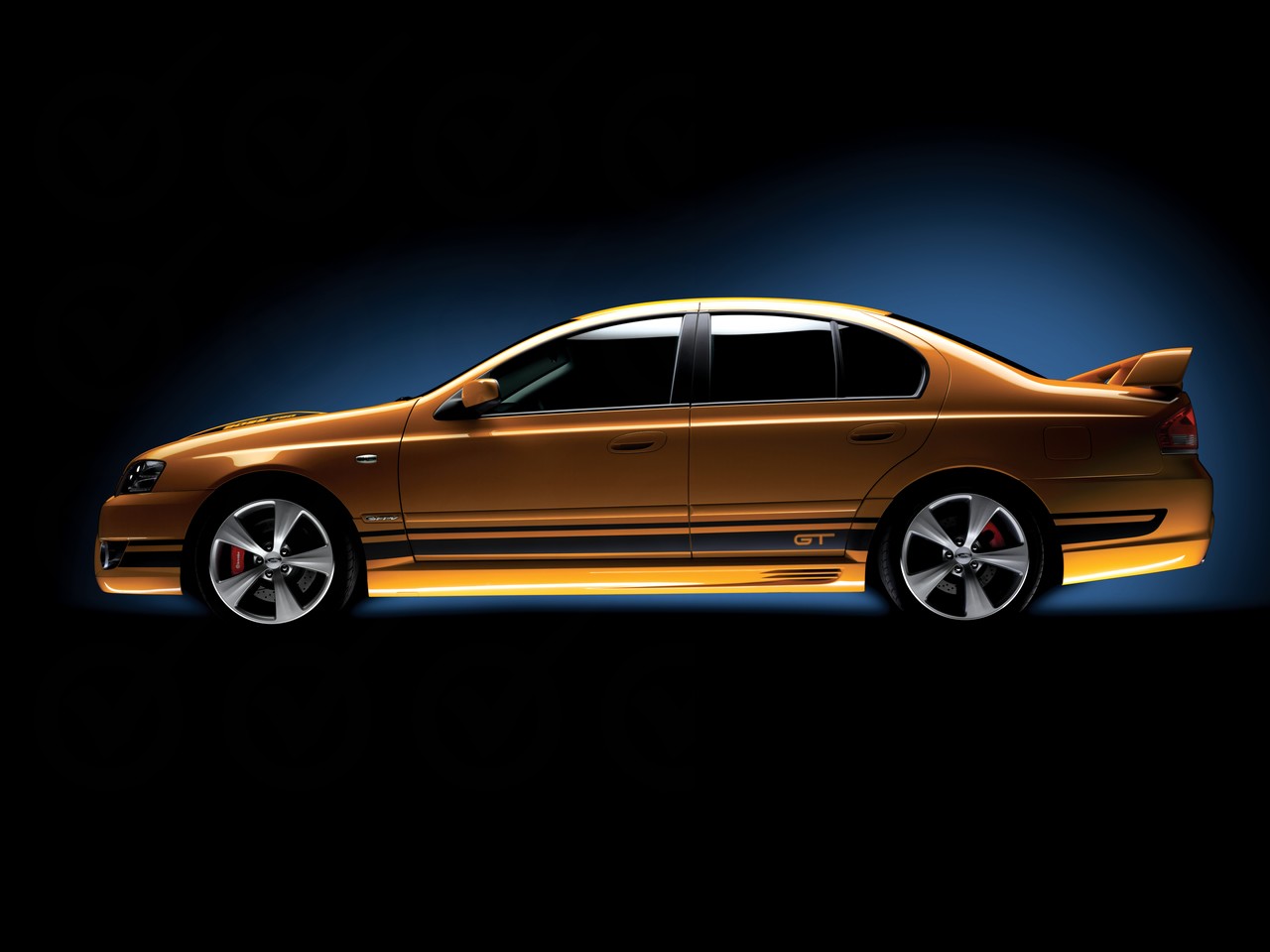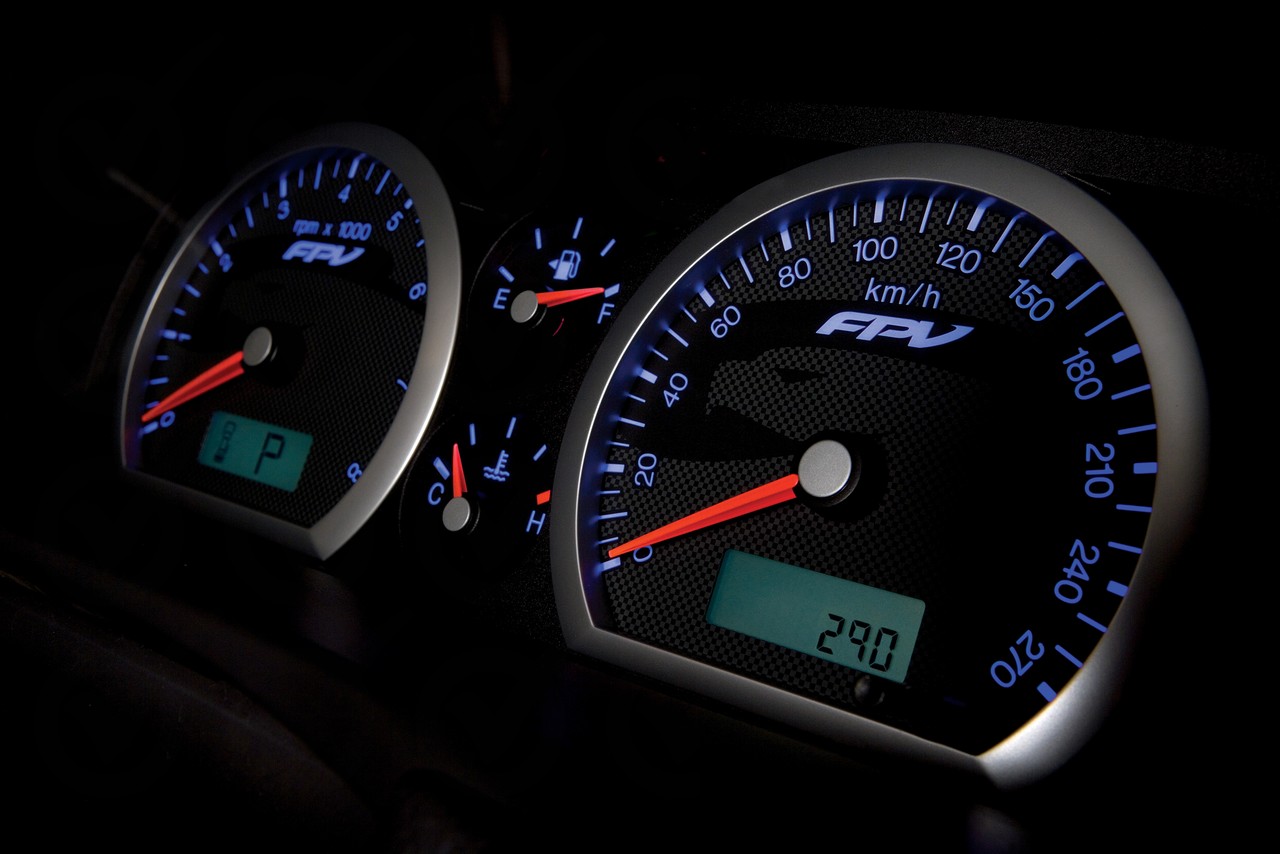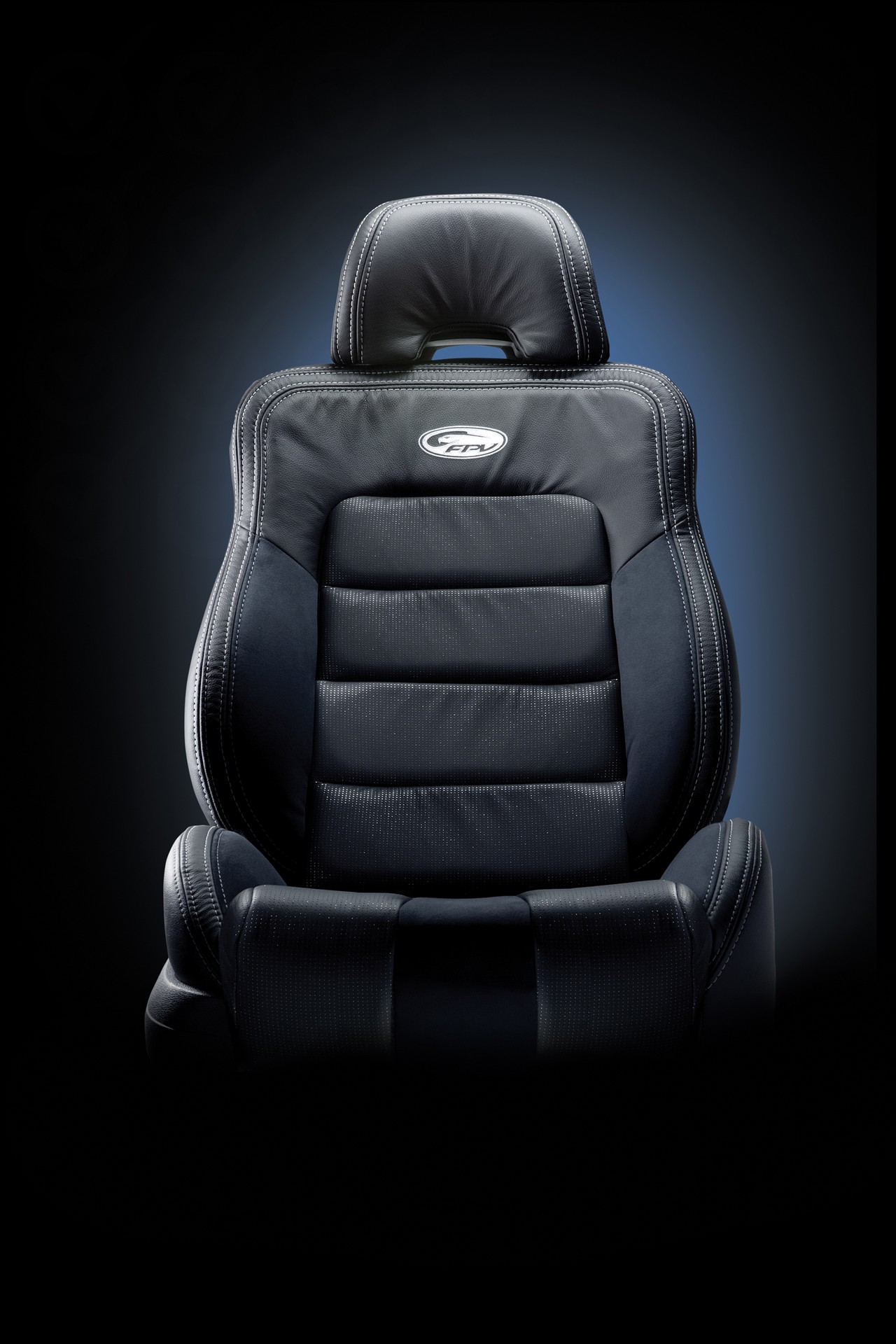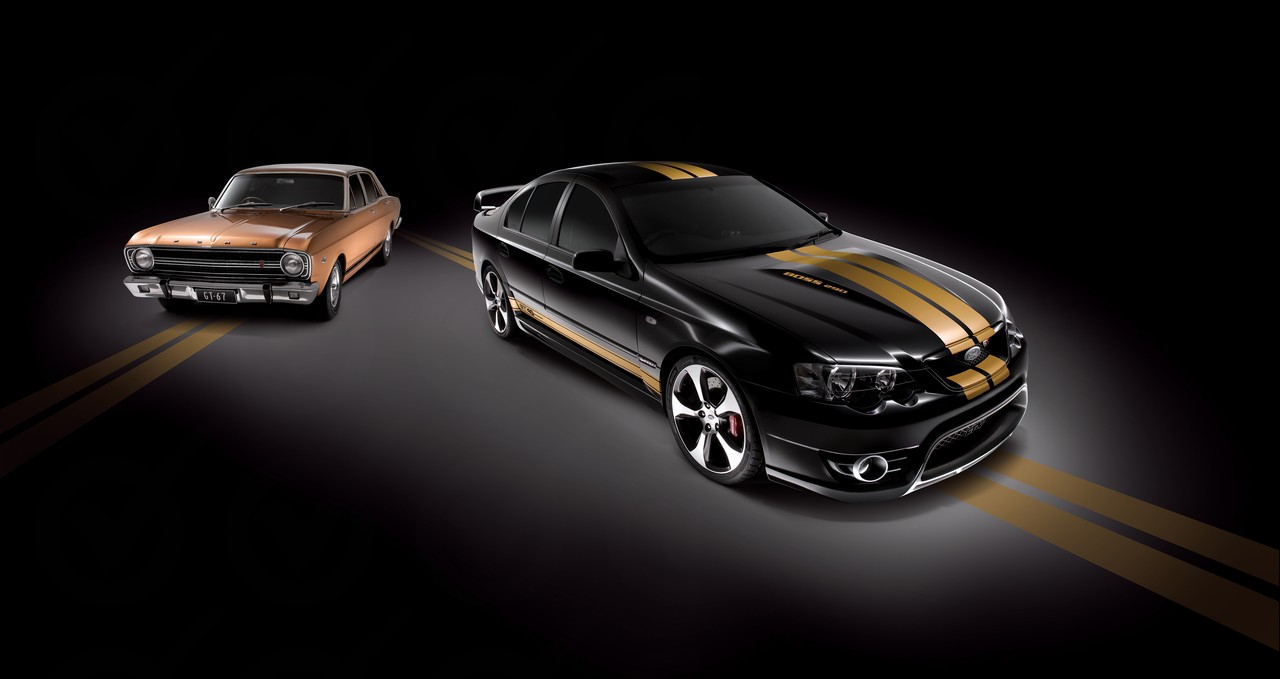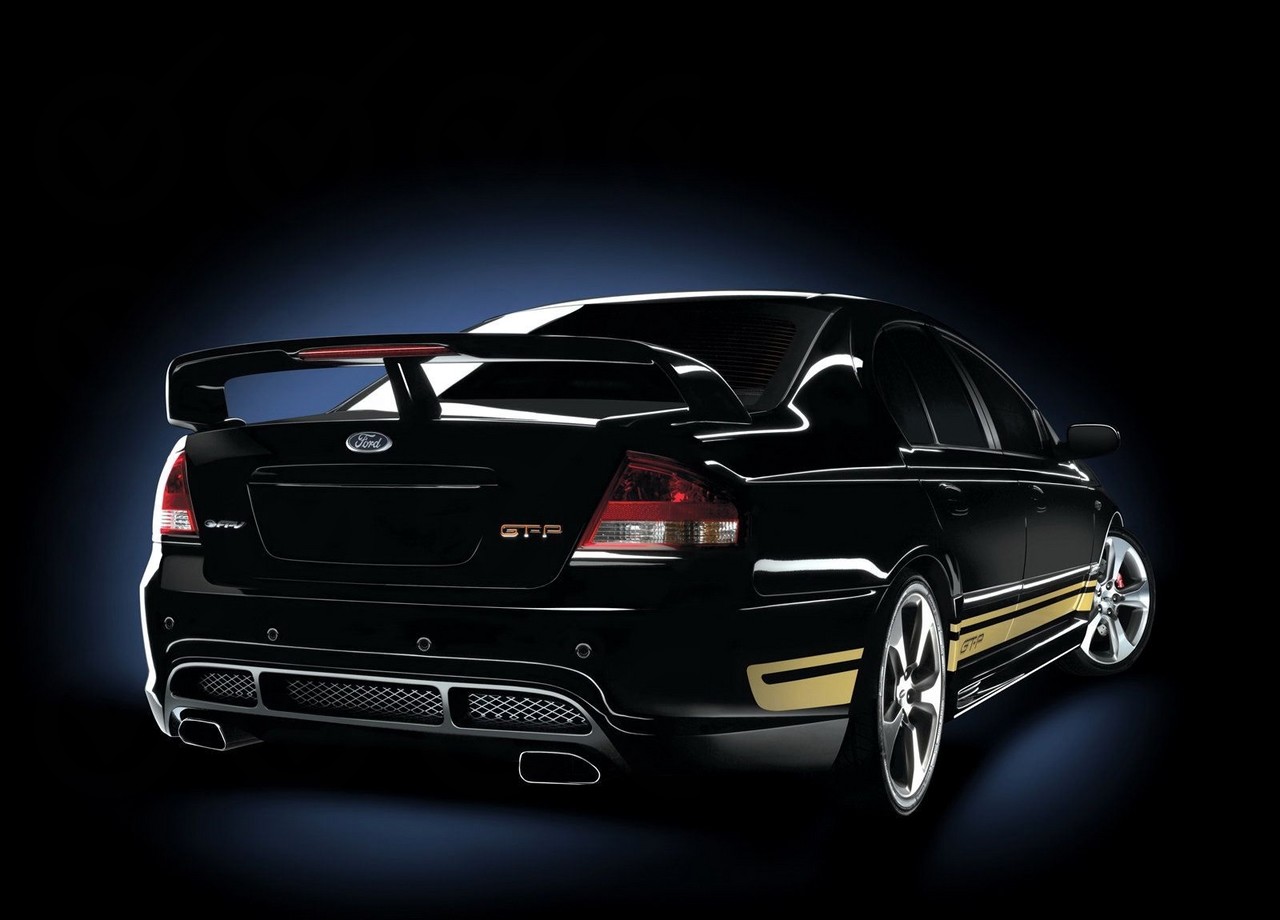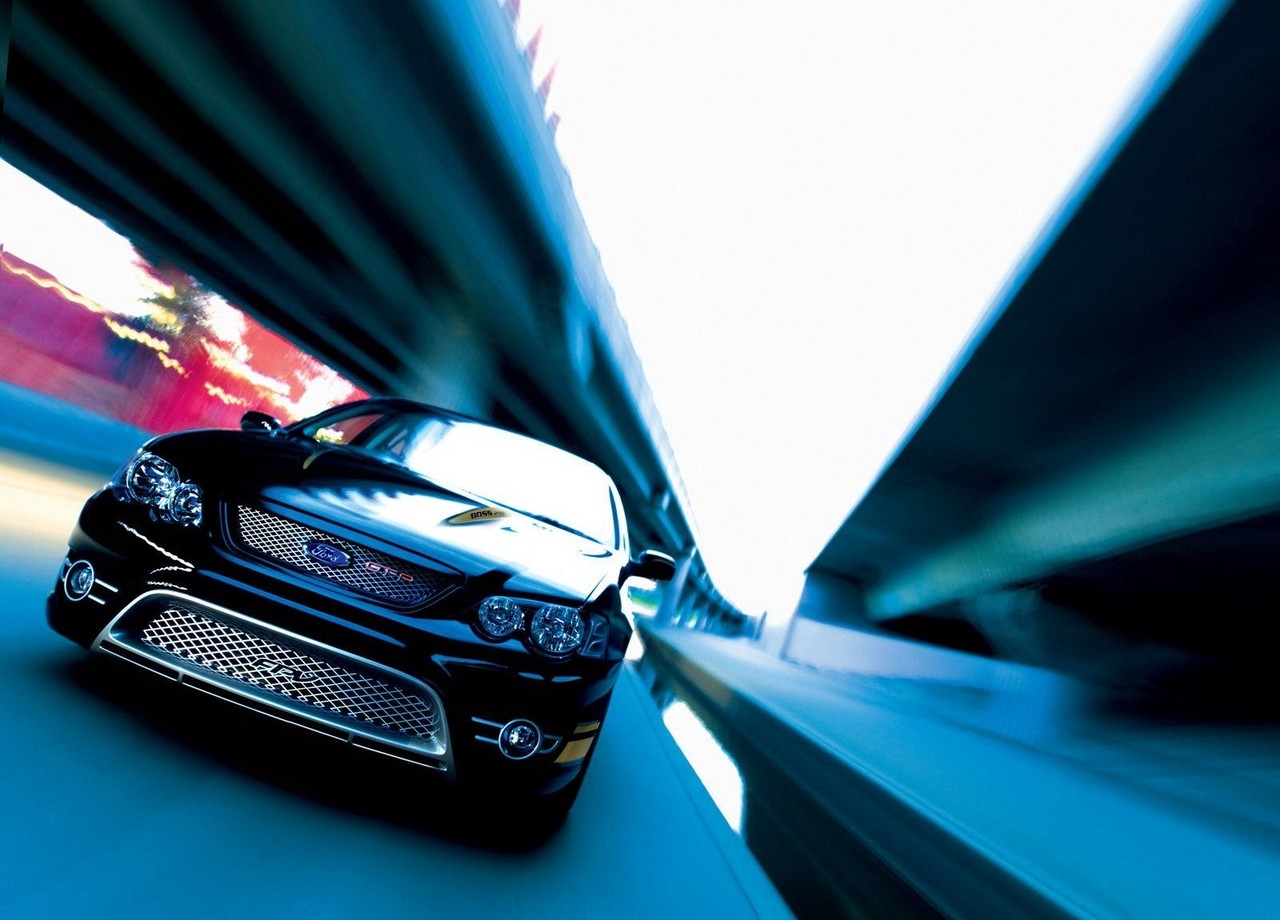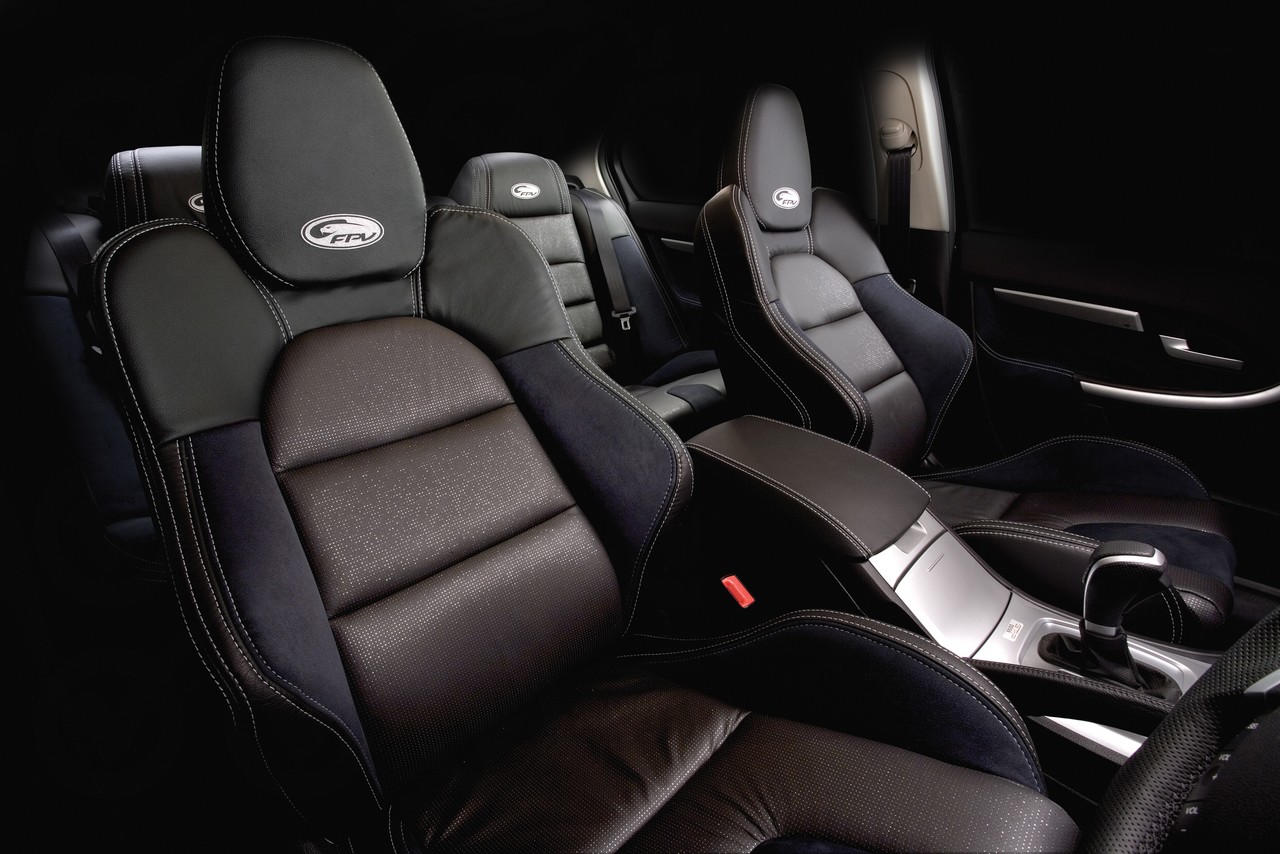
- Powerful ‘Boss 290’ V8 engine
- Impressive dynamics
- Refined six-speed ZF automatic transmission
- Accurate, well-weighted steering
- Powerful Brembo brakes
- For ZF transmission, coolant lines in heat exchanger were susceptible to failure
- Prone to drivetrain clunks
- No curtain airbags or electronic stability control
- ‘Control Blade’ semi-trailing arm rear suspension inferior to VE Commodore-based four-link IRS
Review: FPV BF.I GT and GT-P (2005-06)
Overview
Released in October 2005, the FPV BF Mk.I (BF.I) GT Series consisted of the GT and GT-P models. Manufactured in Campbellfield, Victoria, the GT and GT-P were powered by 5.4-litre Boss 290 V8 petrol engines that were mated to either six-speed manual or automatic transmissions.
Compared to the FPV BA GT , the BF GT Series could be identified by their revised front bumpers, fog lights, ‘jewel-effect’ tail lights and twin exhaust outlets; inside, there were soft-feel door handles.
Boss 290 engine
Assembled by hand in Campbellfield, the 5.4-litre Boss 290 V8 engine had a cast iron block, cast aluminium cylinder head (shared with the Mustang Cobra R), forged steel crankshaft, cross-bolted main bearing caps, sintered connecting rods, double overhead camshafts (DOHC) per cylinder bank, roller finger followers, four valves per cylinder, an alloy inlet manifold, coil on plug ignition and a compression ratio of 10.5:1.
To comply with Euro III emissions standards and new drive-by noise rules (ADR 83/00), changes for the BF Boss 290 engine – relative to its BA predecessor – included:
- A dual ram-entry airbox (first introduced in the BA F6 Typhoon and BA F6 Tornado ) for more efficient induction;
- Twin knock sensors;
- Camshaft timing improvements for a lower idle speed and better idle stability;
- Repositioning the front oxygen sensor from the manifold to the catalyst downpipe for greater accuracy in measuring the air/fuel ratio; and,
- A new exhaust system which consisted of four-into-one extractors from each cylinder bank joining into twin 2 1/4-inch exhaust with an intermediate silencer box. Exhaust gases would then pass through new tri-flow silencers before exiting via the six-inch twin-outlets which featured a trapezoidal design.
For the BF range, ‘transient rpm’ limits were introduced which enabled the engine to momentarily exceed the prescribed rev limit of 6000 rpm during upshifting by 250 rpm (i.e. to 6250 rpm). This enabled wide open throttle upshifting of gears to be scheduled at an engine speed closer to the rev limiter than would otherwise be possible.
Compared to the Boss 260 engine in the Ford BA Falcon XR8 , the Boss 290 engine had:
- High performance pistons with domed tops, larger internal pillars and a special ring pack. As a result of the higher compression ratio (10.5:1), the Boss 290 engine required 95 RON premium unleaded petrol;
- Re-engineered connecting rods to accommodate the larger gudgeon pin of each piston;
- Specially balanced crankshafts to match the new piston and conrod combination;
- High performance tri-metal main and big-end bearings for extra durability;
- Cobra R inlet and exhaust camshaft profiles (for 13 mm inlet and 12 mm exhaust valve lift);
- Longer valve stems and springs to match the high lift camshafts;
- A modified camshaft cradle for the longer finger followers;
- A high-compression ‘Terminator’ head gasket;
- High-tensile head bolts that were stretched under tension for greater strength; and,
- A unique Boss 290 engine management system.
Transmissions
The FPV BF GT and GT-P were available with either:
- Six-speed Tremec T56 manual transmissions; or,
- Newly-introduced six-speed ZF 6HP26 automatic transmissions. The GT and GT-P were fitted with the high-performance version of this transmission – which had upgraded clutches with extra plates in the clutch packs – and a torque capacity of 600 Nm.
The close-ratio six-speed Tremec T56 manual transmission had double synchromesh on all forward gears and single synchromesh on reverse, linear bearings in the shift rail, direct linkage shifters, an electronic reverse gear lockout and a final drive ratio of 3.463:1.
The ZF 6HP26 transmission featured adaptive ‘Driver Recognition’ behaviour, including brake support downshifts, gear holding when cornering, gear holding for uphill and downhill driving and gear holding for fast-off throttle driving situations. Furthermore, the ZF 6HP26 transmission had a remote transmission oil cooler (RTOC) – with a three-way coolant thermostat – that was mounted to the engine block. Acting as a heat exchanger, coolant lines (or tubes) passed through the radiator to warm-up the transmission fluid on start-up and provide cooling under high load/high temperature operating conditions.
Development and dimensions
Like the BF Falcon range, changes for the BF GT and GT-P included:
- The introduction of a two-piece, lofted outer dashboard;
- The addition of bitumastic pads to the body for damping of low- and mid-frequency noises;
- The introduction of an absorptive roof-liner;
- Improved static sealing;
- Body structure improvements through the fitment of a reinforcing box section to the transmission cross member and centre bearing body reinforcement;
- New engine and transmission mounts; and,
- Redesigned exhaust hangers to isolate muffler vibration from the body.
Other developments for the BF range included:
- The introduction of Bosch ABS 8.0 (previously 5.3) which included electronic brake force distribution;
- An upgraded traction control system and the introduction of electronic stability control and cornering brake control;
- A revised pedal map for the electronic throttle control; and,
- A higher-output alternator for improved fuel economy, lower rotational speeds and lower fan speeds.
The FPV BF GT and GT-P were 4917 mm long, 1870 mm wide, 1444 mm tall and had 2829 mm long wheelbases.
Suspension
Like the FPV BA GT , the BF GT and GT-P had double wishbone front suspension. The independent rear suspension (IRS) had three control arms:
- A forged upper control arm;
- A stamped front lower control arm; and,
- A stamped rear lower control arm.
Each control arm had a cross axis ball joint on the wheel assembly end and was attached to the subframe and knuckle. Furthermore, the ‘Control Blade’ was a stamped trailing arm which provided lateral support and acted as a vertical pivot point.
| Engine | Trans. | Peak power | Peak torque | |
|---|---|---|---|---|
| GT, GT-P |
5.4-litre Boss 290 petrol V8 | 6sp auto, 6sp man. |
290 kW at 5500 rpm | 520 Nm at 4500 rpm |
Safety equipment
Standard safety equipment for the FPV BF GT and GT-P included dual front airbags, front side airbags, ABS, electronic brake force distribution, traction control and front seatbelts with pretensioners and load limiters.
Brakes
The FPV BF GT was fitted with a ‘Performance’ braking package which consisted of 355 mm by 32 mm cross-drilled and slotted front brake discs with four-piston Brembo calipers and 328 mm by 26 mm cross-drilled rear discs with single piston calipers.
The GT-P, however, had a ‘Premium’ braking package which had six-piston Brembo front calipers and 330 mm by 28 mm cross-drilled rear discs with four-piston Brembo calipers.
Features: FPV BF GT and GT-P
Standard features for the FPV BF GT included 19-inch five-spoke alloy wheels with machined rims, 245/35 ZR19 Dunlop SP Sport Maxx tyres, a 150 watt sound system with six speakers, a subwoofer, six-disc CD player, dual zone climate control air conditioning, cruise control, TFT colour display, sports seats with suede-feel bolsters, four-way power adjustable driver’s seat, front fog lamps, adjustable front seat lumbar support, automatic headlights, split and folding rear seats, remote central locking, power mirrors and windows, a tilt and reach adjustable steering wheel, trip computer and an immobiliser.
The FPV BF GT-P was further equipped with machined face alloy wheels, more contoured and supportive front seats with colour-coded stitching, rear parking sensors, FPV ‘performance’ steering wheel and floor mats.
The GT and GT-P were both fitted with the Dana M86 limited slip differential which had a wet design heavy-duty multi-plate clutch.
Related links
Review: FPV BF.II GT and GT-P (2006-08)
Overview
Released in October 2006, the BF Mk.II (BF.II) GT Series was a minor update with updated stripe packages, chrome highlights for the air conditioning vents and, for the GT, an FPV performance steering wheel.
Boss 302 engine – November 2007
In November 2007, the Boss 302 V8 engine was introduced. Compared to the Boss 290, changes for the Boss 302 engine included:
- New inlet and exhaust camshaft profile to increase inlet valve lift and duration (necessitating new valves and valve springs);
- A higher compression of 10.8:1 (previously 10.5:1)
- Stainless steel fabricated exhaust manifolds;
- High-flow dual exhaust system; and,
- A revised engine calibration.
| Engine | Trans. | Years | Peak power | Peak torque | |
|---|---|---|---|---|---|
| GT, GT-P |
5.4-litre Boss 290 petrol V8 | 6sp auto, 6sp man. |
2006-07 | 290 kW at 5500 rpm | 520 Nm at 4500 rpm |
| 5.4-litre Boss 302 petrol V8 | 6sp auto, 6sp man. |
2007-08 | 302 kW at 6000 rpm | 540 Nm at 4750 rpm |
Features
Compared to their BF.I predecessors, standard features for the BF.II GT and GT-P were largely unchanged.
2007 FPV GT 40th Anniversary edition
In March 2007, the FPV GT 40th Anniversary edition was released. Visually, the GT 40th Anniversary edition could be identified by its 19-inch GT-P alloy wheels with gloss black accents, ‘Silhouette black’ paint finish with gold stripes and accented side skirts and rear spoilers. Inside, there were leather/suede combination sports seats with silver thread stitching and embroidered GT logo, an iPod/MP3 connection and ’40th Anniversary’ floor mats. The GT 40th Anniversary edition was also fitted with the R-Spec handling pack and a higher capacity oil cooler for automatic models.
2007 FPV GT Cobra
In October 2007, the FPV GT Cobra edition released. The GT Cobra was fitted with the R-Spec handling package and visually distinguished by its 19-inch five-spoke alloy wheels with white accents, Cobra badges on the front fenders and white exterior paint finish with blue bonnet stripes, roof and rear deck lid. Inside, there were leather seats with Cobra logos. The GT Cobra also heralded the introduction of the more powerful V8 engine.
Related links
- Specifications: FPV BF.II GT, GT-P, Pursuit and Super Pursuit (November 2006)
- Ford Newsroom: FPV celebrates 40 years of Ford GT (March 2007)
- Ford Newsroom: FPV Unveils The Cobra (October 2007)
- Wikipedia.org: FPV BF Range


